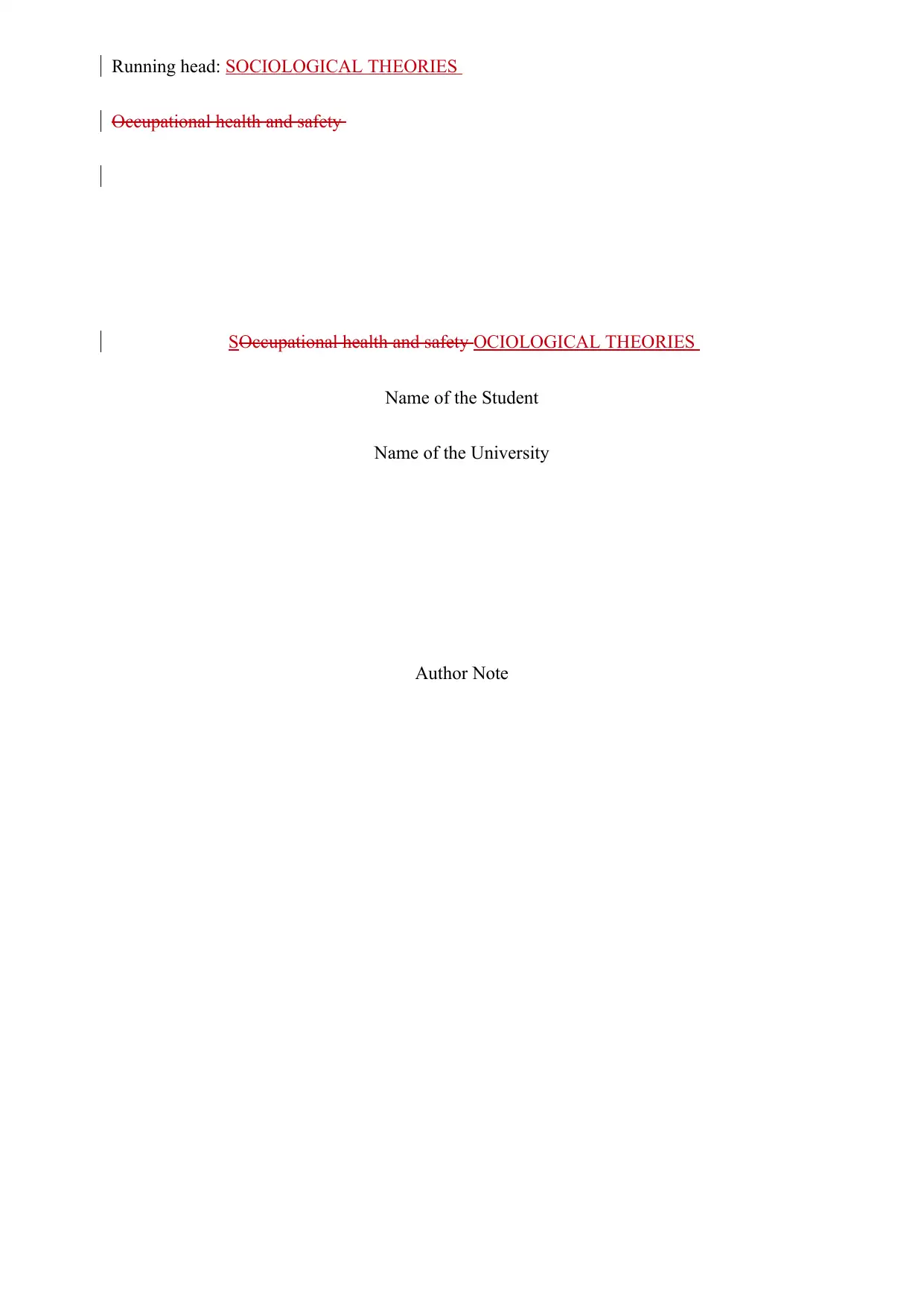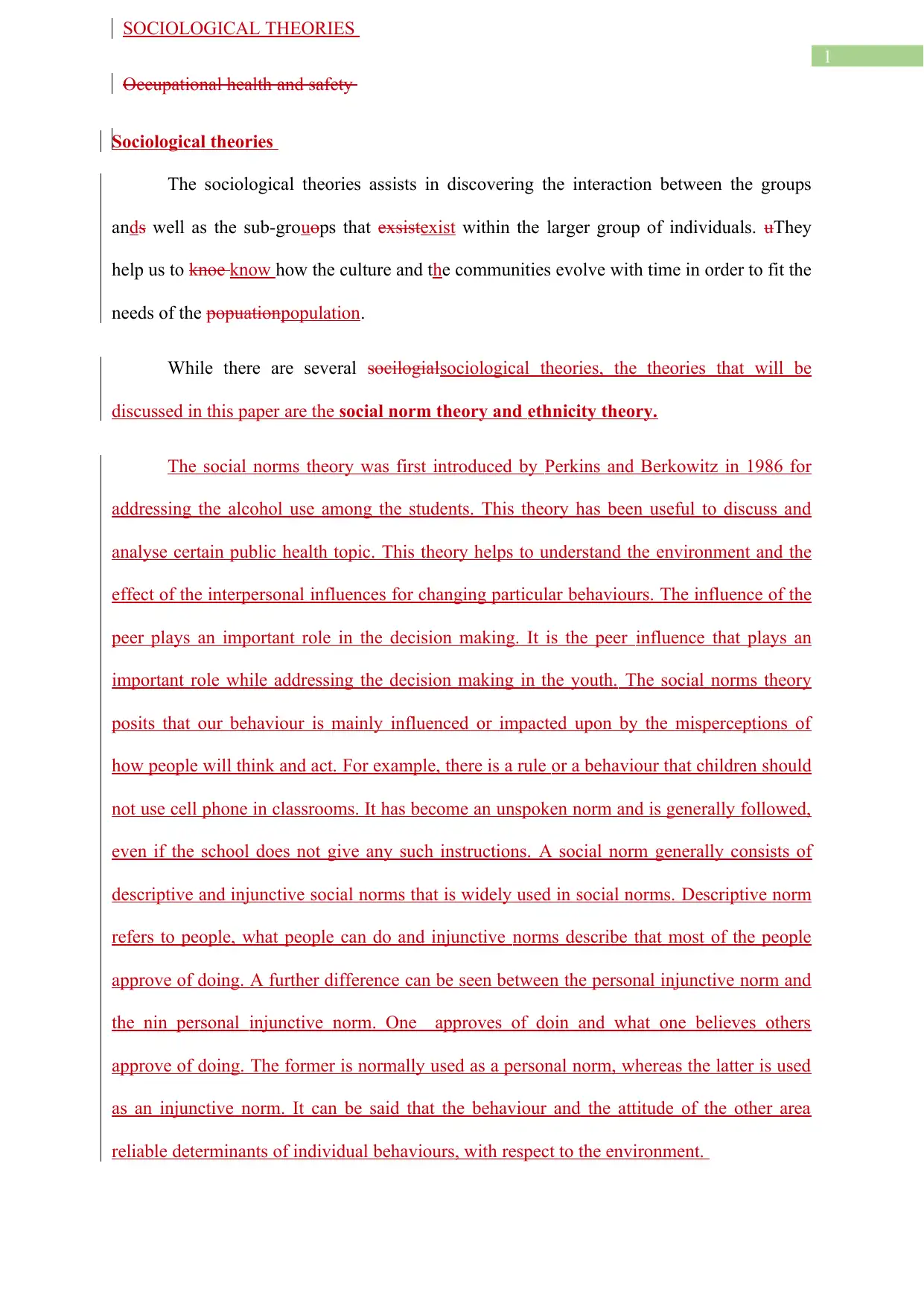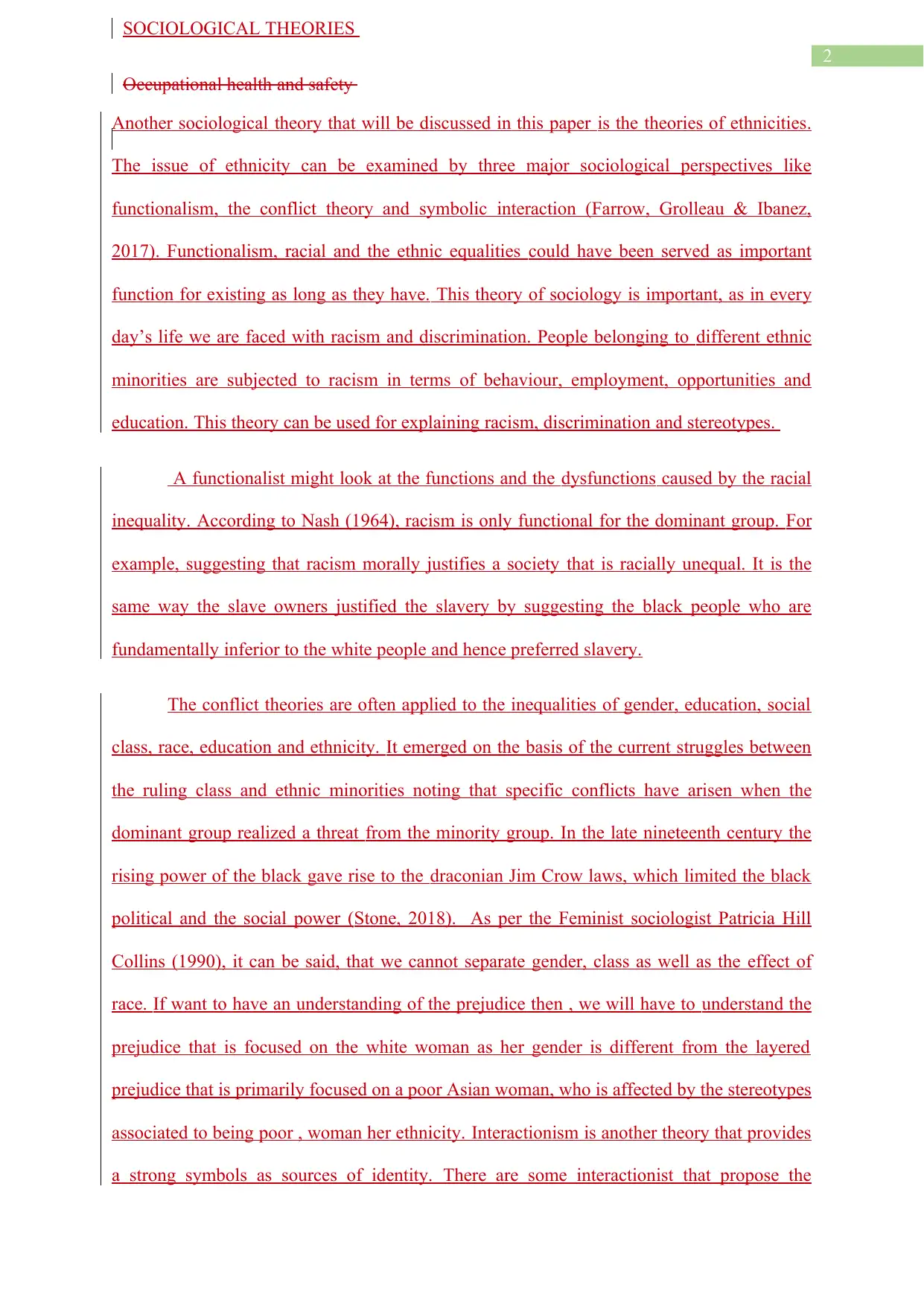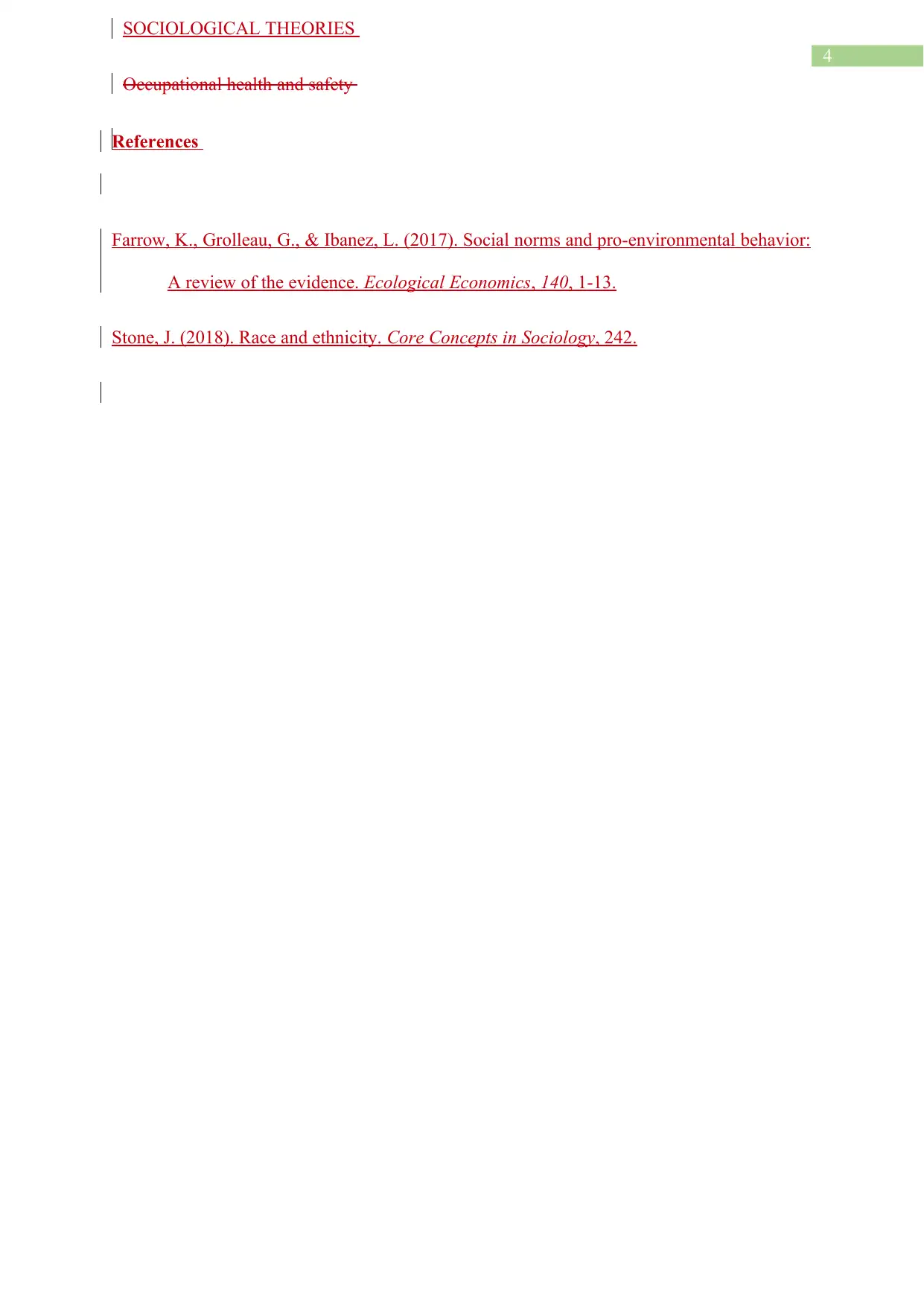Sociological Theories: Exploring Social Norms and Ethnicity Concepts
VerifiedAdded on 2022/08/19
|5
|893
|12
Essay
AI Summary
This essay delves into the realm of sociological theories, examining how they illuminate the interactions within groups and communities and how these evolve over time. The paper specifically explores the social norm theory, introduced to address issues like alcohol use among students, and the ethnicity theory, analyzed through perspectives such as functionalism, conflict theory, and symbolic interactionism. The social norm theory emphasizes the influence of peer groups and misperceptions on behavior, while the ethnicity theory addresses racism, discrimination, and stereotypes within society. References to key concepts like descriptive and injunctive norms, as well as the application of functionalist, conflict, and interactionist viewpoints, are used to provide a comprehensive understanding of these theories and their real-world implications.

Running head: SOCIOLOGICAL THEORIES
Occupational health and safety
SOccupational health and safety OCIOLOGICAL THEORIES
Name of the Student
Name of the University
Author Note
Occupational health and safety
SOccupational health and safety OCIOLOGICAL THEORIES
Name of the Student
Name of the University
Author Note
Paraphrase This Document
Need a fresh take? Get an instant paraphrase of this document with our AI Paraphraser

1
SOCIOLOGICAL THEORIES
Occupational health and safety
Sociological theories
The sociological theories assists in discovering the interaction between the groups
ands well as the sub-grouops that exsistexist within the larger group of individuals. uThey
help us to knoe know how the culture and the communities evolve with time in order to fit the
needs of the popuationpopulation.
While there are several socilogialsociological theories, the theories that will be
discussed in this paper are the social norm theory and ethnicity theory.
The social norms theory was first introduced by Perkins and Berkowitz in 1986 for
addressing the alcohol use among the students. This theory has been useful to discuss and
analyse certain public health topic. This theory helps to understand the environment and the
effect of the interpersonal influences for changing particular behaviours. The influence of the
peer plays an important role in the decision making. It is the peer influence that plays an
important role while addressing the decision making in the youth. The social norms theory
posits that our behaviour is mainly influenced or impacted upon by the misperceptions of
how people will think and act. For example, there is a rule or a behaviour that children should
not use cell phone in classrooms. It has become an unspoken norm and is generally followed,
even if the school does not give any such instructions. A social norm generally consists of
descriptive and injunctive social norms that is widely used in social norms. Descriptive norm
refers to people, what people can do and injunctive norms describe that most of the people
approve of doing. A further difference can be seen between the personal injunctive norm and
the nin personal injunctive norm. One approves of doin and what one believes others
approve of doing. The former is normally used as a personal norm, whereas the latter is used
as an injunctive norm. It can be said that the behaviour and the attitude of the other area
reliable determinants of individual behaviours, with respect to the environment.
SOCIOLOGICAL THEORIES
Occupational health and safety
Sociological theories
The sociological theories assists in discovering the interaction between the groups
ands well as the sub-grouops that exsistexist within the larger group of individuals. uThey
help us to knoe know how the culture and the communities evolve with time in order to fit the
needs of the popuationpopulation.
While there are several socilogialsociological theories, the theories that will be
discussed in this paper are the social norm theory and ethnicity theory.
The social norms theory was first introduced by Perkins and Berkowitz in 1986 for
addressing the alcohol use among the students. This theory has been useful to discuss and
analyse certain public health topic. This theory helps to understand the environment and the
effect of the interpersonal influences for changing particular behaviours. The influence of the
peer plays an important role in the decision making. It is the peer influence that plays an
important role while addressing the decision making in the youth. The social norms theory
posits that our behaviour is mainly influenced or impacted upon by the misperceptions of
how people will think and act. For example, there is a rule or a behaviour that children should
not use cell phone in classrooms. It has become an unspoken norm and is generally followed,
even if the school does not give any such instructions. A social norm generally consists of
descriptive and injunctive social norms that is widely used in social norms. Descriptive norm
refers to people, what people can do and injunctive norms describe that most of the people
approve of doing. A further difference can be seen between the personal injunctive norm and
the nin personal injunctive norm. One approves of doin and what one believes others
approve of doing. The former is normally used as a personal norm, whereas the latter is used
as an injunctive norm. It can be said that the behaviour and the attitude of the other area
reliable determinants of individual behaviours, with respect to the environment.

2
SOCIOLOGICAL THEORIES
Occupational health and safety
Another sociological theory that will be discussed in this paper is the theories of ethnicities.
The issue of ethnicity can be examined by three major sociological perspectives like
functionalism, the conflict theory and symbolic interaction (Farrow, Grolleau & Ibanez,
2017). Functionalism, racial and the ethnic equalities could have been served as important
function for existing as long as they have. This theory of sociology is important, as in every
day’s life we are faced with racism and discrimination. People belonging to different ethnic
minorities are subjected to racism in terms of behaviour, employment, opportunities and
education. This theory can be used for explaining racism, discrimination and stereotypes.
A functionalist might look at the functions and the dysfunctions caused by the racial
inequality. According to Nash (1964), racism is only functional for the dominant group. For
example, suggesting that racism morally justifies a society that is racially unequal. It is the
same way the slave owners justified the slavery by suggesting the black people who are
fundamentally inferior to the white people and hence preferred slavery.
The conflict theories are often applied to the inequalities of gender, education, social
class, race, education and ethnicity. It emerged on the basis of the current struggles between
the ruling class and ethnic minorities noting that specific conflicts have arisen when the
dominant group realized a threat from the minority group. In the late nineteenth century the
rising power of the black gave rise to the draconian Jim Crow laws, which limited the black
political and the social power (Stone, 2018). As per the Feminist sociologist Patricia Hill
Collins (1990), it can be said, that we cannot separate gender, class as well as the effect of
race. If want to have an understanding of the prejudice then , we will have to understand the
prejudice that is focused on the white woman as her gender is different from the layered
prejudice that is primarily focused on a poor Asian woman, who is affected by the stereotypes
associated to being poor , woman her ethnicity. Interactionism is another theory that provides
a strong symbols as sources of identity. There are some interactionist that propose the
SOCIOLOGICAL THEORIES
Occupational health and safety
Another sociological theory that will be discussed in this paper is the theories of ethnicities.
The issue of ethnicity can be examined by three major sociological perspectives like
functionalism, the conflict theory and symbolic interaction (Farrow, Grolleau & Ibanez,
2017). Functionalism, racial and the ethnic equalities could have been served as important
function for existing as long as they have. This theory of sociology is important, as in every
day’s life we are faced with racism and discrimination. People belonging to different ethnic
minorities are subjected to racism in terms of behaviour, employment, opportunities and
education. This theory can be used for explaining racism, discrimination and stereotypes.
A functionalist might look at the functions and the dysfunctions caused by the racial
inequality. According to Nash (1964), racism is only functional for the dominant group. For
example, suggesting that racism morally justifies a society that is racially unequal. It is the
same way the slave owners justified the slavery by suggesting the black people who are
fundamentally inferior to the white people and hence preferred slavery.
The conflict theories are often applied to the inequalities of gender, education, social
class, race, education and ethnicity. It emerged on the basis of the current struggles between
the ruling class and ethnic minorities noting that specific conflicts have arisen when the
dominant group realized a threat from the minority group. In the late nineteenth century the
rising power of the black gave rise to the draconian Jim Crow laws, which limited the black
political and the social power (Stone, 2018). As per the Feminist sociologist Patricia Hill
Collins (1990), it can be said, that we cannot separate gender, class as well as the effect of
race. If want to have an understanding of the prejudice then , we will have to understand the
prejudice that is focused on the white woman as her gender is different from the layered
prejudice that is primarily focused on a poor Asian woman, who is affected by the stereotypes
associated to being poor , woman her ethnicity. Interactionism is another theory that provides
a strong symbols as sources of identity. There are some interactionist that propose the
⊘ This is a preview!⊘
Do you want full access?
Subscribe today to unlock all pages.

Trusted by 1+ million students worldwide

3
SOCIOLOGICAL THEORIES
Occupational health and safety
symbols of race and not the race itself, which leads to racism. As stated by interactionist,
prejudice is entirely caused by the interaction between the members of the dominant group.
However, it can said that functionalist view of the race studies the dominant role and the
subordinate groups develop a stable social structure.
SOCIOLOGICAL THEORIES
Occupational health and safety
symbols of race and not the race itself, which leads to racism. As stated by interactionist,
prejudice is entirely caused by the interaction between the members of the dominant group.
However, it can said that functionalist view of the race studies the dominant role and the
subordinate groups develop a stable social structure.
Paraphrase This Document
Need a fresh take? Get an instant paraphrase of this document with our AI Paraphraser

4
SOCIOLOGICAL THEORIES
Occupational health and safety
References
Farrow, K., Grolleau, G., & Ibanez, L. (2017). Social norms and pro-environmental behavior:
A review of the evidence. Ecological Economics, 140, 1-13.
Stone, J. (2018). Race and ethnicity. Core Concepts in Sociology, 242.
SOCIOLOGICAL THEORIES
Occupational health and safety
References
Farrow, K., Grolleau, G., & Ibanez, L. (2017). Social norms and pro-environmental behavior:
A review of the evidence. Ecological Economics, 140, 1-13.
Stone, J. (2018). Race and ethnicity. Core Concepts in Sociology, 242.
1 out of 5
Related Documents
Your All-in-One AI-Powered Toolkit for Academic Success.
+13062052269
info@desklib.com
Available 24*7 on WhatsApp / Email
![[object Object]](/_next/static/media/star-bottom.7253800d.svg)
Unlock your academic potential
Copyright © 2020–2025 A2Z Services. All Rights Reserved. Developed and managed by ZUCOL.





